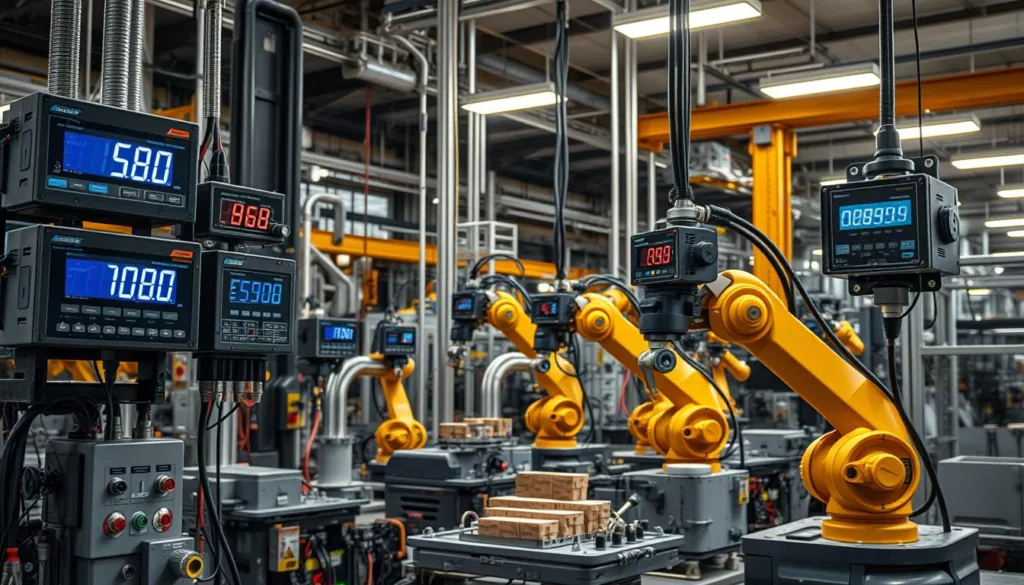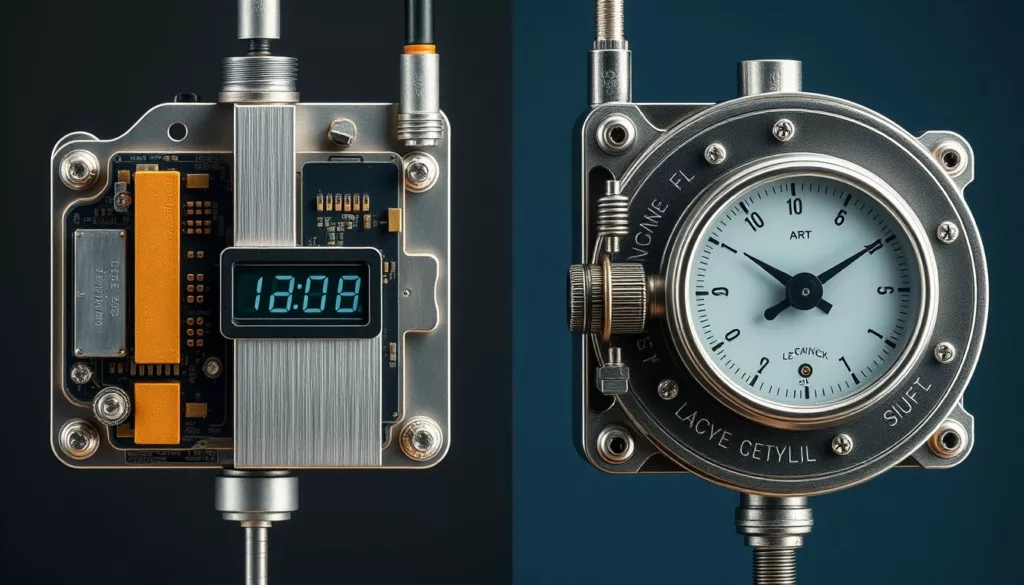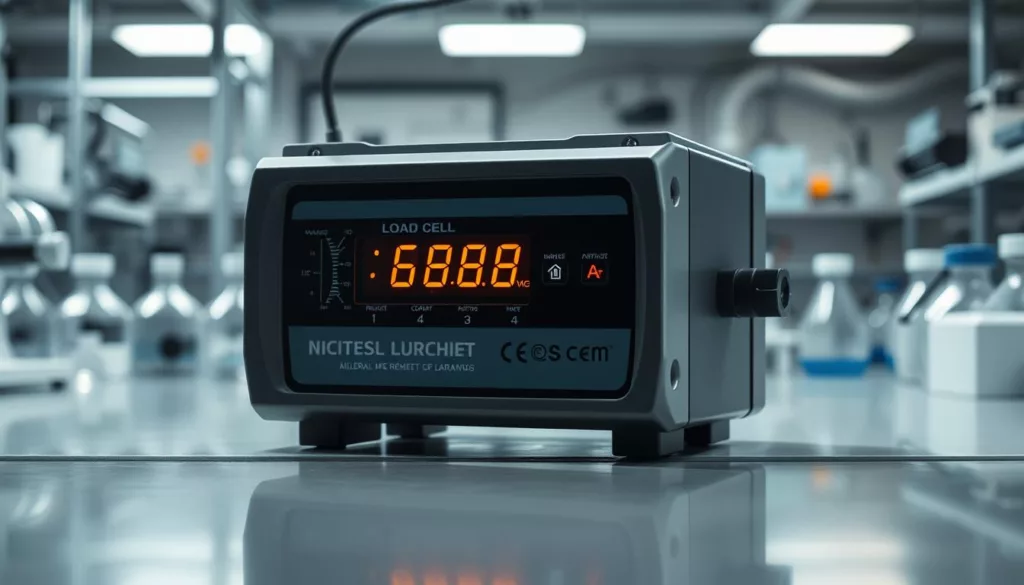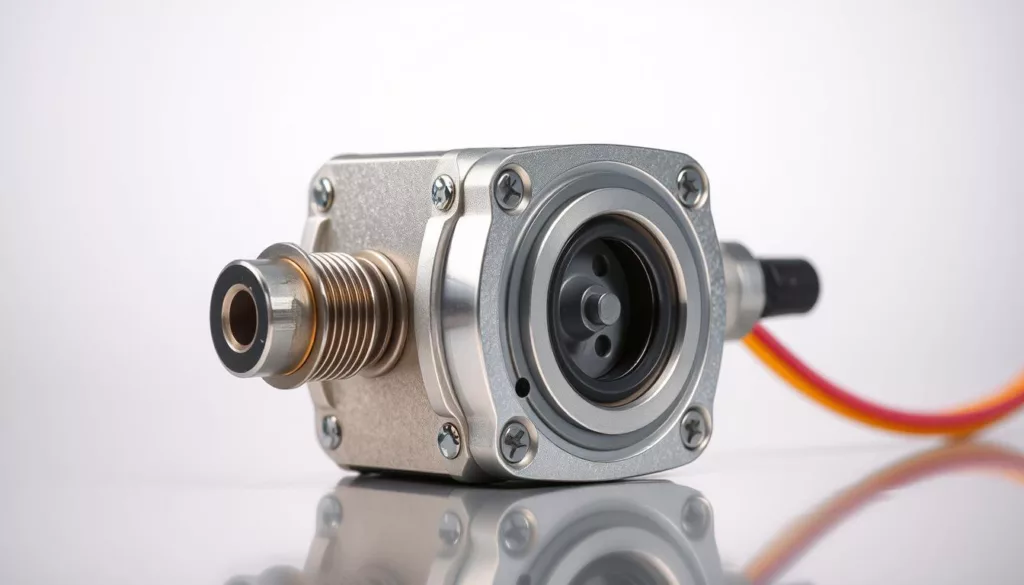In the world of precision weighing and force measurement, picking between digital and analog load cells is key. This choice affects your application’s performance and cost. Load cells are the core of any weighing system, with different types suited for various needs.
This article will explore the main differences between digital and analog load cells. We’ll look at their advantages, limitations, and what to consider when choosing. Whether you’re in industry, engineering, or procurement, this guide will help you understand load cell technology. It will aid in making a choice that meets your operational needs.
Key Takeaways
- Digital and analog load cells have different strengths and weaknesses in signal quality, accuracy, cost, and integration.
- Knowing your weighing application’s needs is vital in picking the right load cell technology.
- Consider performance metrics, calibration, and long-term costs when deciding between digital and analog load cells.
- Some industries or scenarios might prefer one technology over the other due to specific needs.
- Choosing the right load cell technology can greatly affect your weighing system’s efficiency, reliability, and cost.
Understanding Load Cells and Their Applications
Load cells are key to industrial automation in many areas. They turn force or weight into an electrical signal. This signal is then used for control and monitoring.
What is a Load Cell?
A load cell is a device that changes mechanical force into an electrical signal. This signal can be a change in voltage or resistance. It helps electronic systems measure the force accurately. Load cells have different capacity ranges and signal transmission methods for various needs.
Common Applications of Load Cells
- Weighing systems (e.g., scales, hopper weighing, truck scales)
- Material handling equipment (e.g., conveyor belt systems, packaging machines)
- Process control and monitoring (e.g., mixing, filling, batching)
- Force and tension measurement (e.g., in cranes, presses, and testing machines)
Importance of Load Cells in Industry
Load cells are vital in industrial automation. They give accurate, real-time data on forces and weights in operations. This data is key for quality control, production efficiency, and safety.
By measuring and monitoring capacity range and signal transmission, load cells are essential for optimizing industrial operations.
“Load cells are the unsung heroes of industrial automation, providing the essential data that enables precise control and optimization of complex manufacturing processes.”
The Basics of Analog Load Cells
Analog load cells are key in precision weighing systems. They help send accurate signals and measure weight. These devices use strain gauges to turn force into electrical signals. This makes them reliable for weight monitoring in many industries.
How Analog Load Cells Work
Analog load cells change electrical resistance when force is applied. They have a bridge circuit with strain gauges. These gauges detect small changes in the load cell’s shape.
When weight is added, the gauges’ resistance changes. This change sends an electrical signal. The signal is then amplified and processed for weight measurements.
Advantages of Analog Load Cells
- They are simple and cost-effective, making them a good choice for many uses.
- Their sturdy design and resistance to environmental factors ensure reliable performance.
- They work well with a variety of analog signal transmission and processing equipment.
- They are easy to calibrate and maintain, keeping accuracy over time.
Limitations of Analog Load Cells
Analog load cells have some drawbacks. These include:
- They have lower resolution and accuracy than digital load cells, which is a problem for precise measurements.
- They can be affected by external factors like electromagnetic fields or temperature changes, which can harm signal quality.
- They can’t handle advanced features like digital filtering or temperature compensation, which improve measurement quality.
To overcome these issues, many turn to digital load cells. Digital load cells offer better accuracy, flexibility, and advanced features. The choice between analog and digital load cells depends on the application’s needs, considering cost, performance, and integration.
The Essentials of Digital Load Cells
Digital load cells are a key part of modern industrial automation. They offer a big advantage over old-style sensors. This makes them a game-changer for weighing and measuring tasks.
How Digital Load Cells Work
Digital load cells mix advanced electronics with precise mechanics. They turn physical force into a digital signal. This signal is then processed and analyzed by control systems.
This digital signal is faster and more accurate. It makes digital load cells perfect for tough industrial jobs.
Advantages of Digital Load Cells
- They give better signal quality and accuracy. This means precise and reliable measurements, even in tough spots.
- Digital signal transmission means no need for analog-to-digital conversion. This cuts down on signal loss and interference.
- They work well with industrial automation and control systems. This lets for real-time monitoring and process improvement.
Limitations of Digital Load Cells
Despite their benefits, digital load cells have some downsides. They might cost more than analog ones at first. The digital parts also need special care and support.
In some cases, analog signals are better. So, digital load cells might not be the best choice for every situation.
| Feature | Analog Load Cells | Digital Load Cells |
|---|---|---|
| Signal Transmission | Analog | Digital |
| Signal Quality | Susceptible to interference | Highly accurate and stable |
| Automation Integration | Requires additional conversion | Seamless integration |
| Cost | Generally lower | Potentially higher initial investment |
Choosing between digital and analog load cells depends on your needs. Look at the accuracy and automation integration you need. This will help you decide what’s best for your business.
Key Differences Between Digital and Analog Load Cells
Choosing between digital and analog load cells is key for precise weight measurement. Knowing the differences helps pick the right load cell types for precision weighing.
Signal Quality and Accuracy
Digital load cells have better signal quality and accuracy than analog ones. Their digital signal processing leads to more precise measurements. This makes them ideal for applications needing which to choose? top-notch accuracy.
Cost Considerations
Digital load cells cost more upfront but save money in the long run. They need less maintenance, which can save you money. Analog load cells are cheaper but might not last as long.
Ease of Integration
Digital load cells work well with modern systems and computers. This makes setup and data handling easier. They’re great for complex load cell types and automated systems.
| Comparison Factor | Digital Load Cells | Analog Load Cells |
|---|---|---|
| Signal Quality | Superior | Moderate |
| Accuracy | Higher | Lower |
| Cost | Higher initial investment | More affordable |
| Integration | Easier integration with modern systems | Requires additional signal conditioning |
Choosing between digital and analog load cells depends on your needs, budget, and system integration. By understanding these differences, you can pick the best load cell transmitter. This ensures accurate and reliable weight measurements.
Performance and Calibration: A Comparative View
When it comes to force measurement and precision weighing, how you calibrate and measure performance matters a lot. Let’s look at the main differences between analog and digital load cells.
Calibration Process for Analog Load Cells
Analog load cells need a detailed calibration process. You have to apply known capacity range weights and adjust the output signal. This process is time-consuming and needs special skills to get it right.
Calibration Process for Digital Load Cells
Digital load cells have a simpler calibration process. Many come pre-calibrated, making setup easier. Some can even be calibrated with software, saving time and effort.
Performance Metrics
- Accuracy: Digital load cells are more accurate and consistent, which is great for force measurement at lower capacities.
- Stability: Digital load cells stay stable over time, ensuring consistent precision weighing.
- Resolution: They offer higher resolution, leading to more precise measurements and better data analysis.
| Performance Metric | Analog Load Cells | Digital Load Cells |
|---|---|---|
| Accuracy | Moderate | High |
| Stability | Moderate | High |
| Resolution | Moderate | High |
Knowing the differences in calibration and performance helps users choose the right load cells. Whether you need analog or digital load cells depends on your force measurement and precision weighing needs.
Applications Best Suited for Digital Load Cells
Digital load cells are now the top choice for industrial automation and weighing. They offer unmatched precision and versatility. This makes them ideal for many scenarios.
Scenarios Favoring Digital Technology
Digital load cells shine when accuracy is key. They work well in places with changing temperatures, vibrations, or electromagnetic fields. Their reliability is unmatched. Plus, they easily fit into automated systems, making them a favorite in industrial automation.
Industries Utilizing Digital Load Cells
- Food and Beverage Production: Digital load cells ensure precise ingredient measurements, enabling consistent product quality and reduced waste.
- Pharmaceutical Manufacturing: These sensors play a critical role in the precise weighing of active ingredients and excipients, essential for regulatory compliance.
- Logistics and Warehousing: Digital load cells provide accurate and real-time weight data, optimizing inventory management and logistics operations.
- Engineering and Manufacturing: From assembly line weighing to heavy machinery calibration, digital load cells deliver the precision required for these industries.
Digital load cells are vital in industrial automation and weighing applications across various sectors. They offer precise, reliable, and consistent measurements. This makes them the top choice for those looking to improve their processes and boost productivity.
“Digital load cells have revolutionized the way we approach industrial automation and precision weighing. Their versatility and performance have been instrumental in driving efficiency and quality across a wide range of industries.”
Applications Best Suited for Analog Load Cells
Analog load cells are popular in certain areas, even with digital load cells being trendy. They are great for specific needs in industries. Their strengths make them perfect for certain tasks.
Scenarios Favoring Analog Technology
Analog load cells are best in places where they can last long and work well. They’re great for tough jobs like:
- Heavy-duty industrial scales in manufacturing, mining, and construction
- Outdoor scales that face bad weather
- Places with lots of electromagnetic interference (EMI)
- Old systems that need to work with existing analog gear
Industries Utilizing Analog Load Cells
Many industries use analog load cells. Here are a few:
- Agriculture and Farming: They’re used in livestock scales and grain silos. Accuracy and reliability are key here.
- Transportation and Logistics: Truck and rail scales use strong analog load cells.
- Manufacturing and Processing: They’re used in tough places like steel and paper mills. They can handle harsh conditions.
Even though digital load cells have changed the game, analog tech is not going away. It’s perfect for jobs that need durability and cost savings. Knowing when to use analog load cells helps professionals choose the best tools for their work.
Cost Analysis: Digital vs. Analog Load Cells
Choosing between digital and analog load cells for your industrial needs is important. We’ll look at the costs to help you decide which load cell types are best.
Initial Investment Costs
Digital load cells usually cost more at first. This is because they use advanced tech for digital signals and communication. But, their extra features and precision make them worth it, mainly in industrial automation.
Long-term Operational Costs
Even though digital load cells start off pricier, they save money in the long run. They need less upkeep and calibration, saving on maintenance costs. Their better data and connectivity also boost efficiency, cutting down on expenses.
When looking at the total cost, think about your industrial automation project’s needs. Things like accuracy and how well they fit with your system are key. They can make digital or analog load cells the better choice to choose.
“Investing in the right load cell technology can have a significant impact on the long-term success and profitability of your industrial automation system.”
By weighing the initial and ongoing costs, you can choose wisely. This choice will fit your budget and goals, improving your industrial automation system’s efficiency and performance.
Making the Right Choice for Your Needs
Choosing the right load cell technology is key for your weighing needs. You must consider digital vs. analog load cells. Think about signal quality, accuracy, cost, and how easy they are to use. Knowing the strengths and weaknesses of each helps you pick the best one for your needs and budget.
Factors to Consider When Choosing
When picking between digital and analog load cells, think about precision, system complexity, and maintenance. Analog load cells are good for simple, budget-friendly tasks. Digital load cells are better for precise measurements and easy connectivity.
Expert Recommendations
XJCSENSOR experts suggest looking closely at your weighing needs. For high-accuracy and easy data integration, digital load cells are best. But, if you need something simple and affordable, analog load cells might be the way to go.








